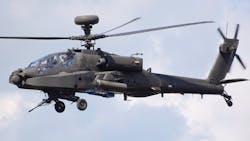Are nanotubes key to better helicopter blades?
Engineers at the Army Research Laboratory are exploring the use of carbon nanotubes to make helicopter blades perform better. Nanotubes have been shown to dissipate energy when embedded in small samples of composite materials, thus improving the material’s damping qualities. Army researchers are looking for the same effect when embedding nanotubes in larger components — helicopter blades. The need for better blades emerged from deficiencies uncovered in the Iraq and Afghanistan wars. Helicopters spent too much time in maintenance, and they weren’t fast enough nor able to carry enough cargo.
Currently, aerospace engineers compromise between stability and vibrations when designing helicopter blades. Blades with good stability tend to transmit vibrations to the aircraft, boosting the need for maintenance. But blades that limit vibrations have stability issues that limit aircraft performance. This trade-off prevents development of next-generation design concepts with improved payloads, speeds, range, and cost.
Army engineers are placing nanotubes throughout the blade or concentrating them near the hub to see how they affect damping. The theory is that the friction at the nanotube-resin interface will dissipate energy and improve damping, making the blades more stabile while fibers in the composite resin provide the strength and stiffness.
Resources: Army Research Laboratory

